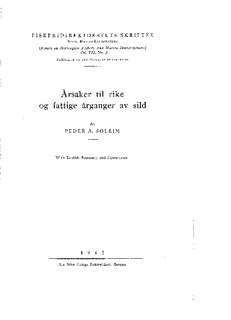Årsaker til rike og fattige årganger av sild
Research report
Permanent lenke
http://hdl.handle.net/11250/114490Utgivelsesdato
1942Metadata
Vis full innførselSammendrag
Causes of rich and poor Year-classes of Herring.
This paper continues RUNNSTRØMS investigation on herring larvæ
during 1932-35 and is based on material obtained by hatching artificially
fertilized eggs as well as on plankton material from the West
Coast during late winters.
In a preliminary account of the work (1940) the author pointed
out that the artificially bred larvæ as well as those found in the sea
went through a "critical stage" when the yolk was consumed, and that
the greater number of the larvæ were unable to survive this dangerous
epoch. This stage was described in detail and the cause of the great
mortality ascribed to lack of suitable food. It was furthermore pointed
out from experience gained by tow-netting that the herring larvæ
were not encountered at the surface in sunshine but only at some depth.
By measuring many hundreds of larvæ it was found that the critical
stage occurred about the end of March.
In the present paper the experiments with fertilizing and hatching
of the eggs and feeding of the larvæ are treated in more detail.
The salinity was found to be unimportant within the range 22,17
-33,57 per mille. The influence of temperature investigated more
closely and it was found that the biological zero-point of the herring
egg is situated at approx. ÷ 1.2° C, and that the product of the time
and the average temperature (counted from the biol. 0-point) was
nearly constant in all hatching experiments, the latest as well as those
made in earlier years.
It was furthermore found that light is of great importance for
the act of feeding of the larvæ. Contrary to earlier conceptions it
was found that a vegetarian diet alone was unable to keep the larvæ
alive in early life. It was observed that the larvæ, provided suitable
illumination, were catching and eating barnacle-nauplii (Balanus balanoides)
and those of the "brine shrimp" (Artemia salina) even before
the yolk was completely used up. Such food enable the larvæ to be
kept a long time beyond the critical stage.
Tow-nettings in the later years corroborate the findings mentioned
above, that the larvæ avoid direct sunshine and keep to a twilight zone.
In the period succeeding the great reduction in the number of
larvæ found in the plankton, great quantities of dead and semidissolved
herring larvæ appeared in the catches and in these place the
sea was exceptionally poor in nauplii. In other catches it appeared
that eggs and nauplii of copepods (above all of Calanus finmarchicus)
most commonly are found as the first gut-content of the herring
larvæ, along with remains of diatoms.
The later spreading and transport of the herring fry takes place
both northwards along the coast with the coastal stream and into the
fjords by means of the tidal currents. Investigations in the little
landlocked fjord Nordåsvannet (near Bergen) from spring to autumn
1941 showed the occurrence of herring fry but only after it had passed
through its metamorphosis into "whitebait" which must have been
carried into the fjord by the very strong tidal current through the
narrow entrance.
Utgiver
[Fiskeridirektoratets havforskningsinstitutt]Serie
Fiskeridirektoratets skrifter, serie havundersøkelservol 7 no 2
